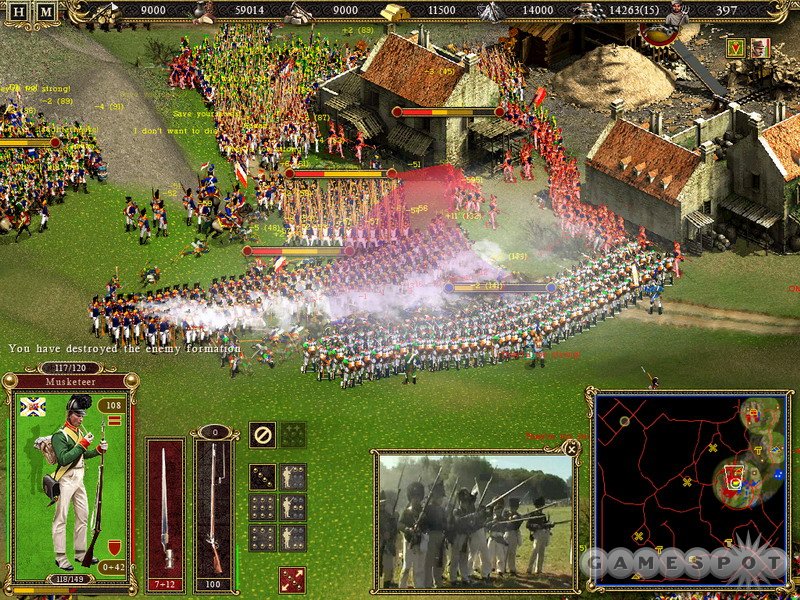Cossacks II: Battle for Europe Hands-On - Tougher AI for More Challenging Napoleonic-era Battles
We get our hands on the upcoming stand-alone expansion for Cossacks II: Napoleonic Wars to see how far early 19th century warfare has evolved.
Compared to the chaos of modern wars, warfare in the early 19th century was a highly formalized affair. Thousands of men marched in formation around the battlefield, lined up against an enemy formation, and then the two exchanged fire until one side broke. This stylized form of warfare has its appeal, especially for strategy fans, and it's something that we'll get to see more of with Cossacks II: Battle for Europe, a stand-alone expansion for last year's Cossacks II: Napoleonic Wars. We've been playing around with a near-final version of the game to see what's new and improved.

It's a bit odd that CDV chose to name this expansion Battle for Europe, since that's also the name of one of the existing gameplay modes in Napoleonic Wars. As a stand-alone expansion, Battle for Europe doesn't add a lot of new content to the existing gameplay of the Napoleonic Wars, but what it does add seems promising. Battle for Europe bumps the number of playable nations in the game to nine, with the introduction of Spain, the Great Duchy of Warsaw, and the Rhine Confederation. There are 10 new battlefields, four new campaigns, and three new historical battles. These are actually three pretty significant battles (Waterloo, Leipzig, and Borodino), which makes you kind of wonder how they were overlooked before.
We also get the sense that the artificial intelligence is tougher and smarter in Battle for Europe, which is good news for players who found it too easy to manipulate the AI in Napoleonic Wars. In that game, the AI was content to send formations at you in steady waves, letting you send them to their doom. Now, in Battle for Europe, the AI seems a lot more careful about keeping units out of your range, and when you finally do waste your fire, the computer seems smart enough to attack while your men are busy reloading their rifles, a process that took forever and a half in those days. Also, the AI seems to be better about flanking your formations, as well as using cavalry to exploit any openings on the battlefield.
The gameplay modes remain the same as those in Napoleonic Wars--you can battle it out in skirmishes and partake in a number of different campaigns. And then there's the Battle for Europe mode, which is similar to the campaigns found in the popular Total War games. In Battle for Europe, you'll command one of the nine European nations as you attempt to conquer the continent. A turn-based strategic layer will let you move armies to various provinces in order to invade or defend them. Each provice provides different amounts of resources, which you'll need to either build up defenses or to keep your army going. While in this mode, you can also forge alliances and conduct other diplomatic business, as warfare in this era was defined by grand alliances and coalitions.

When two armies meet, the game drops down to the real-time battlefield map. Battlefields actually represent large areas of territory, with various villages and towns scattered around the map connected by a network of roads. Each settlement supplies a different resource, such as food or coal, and if you seize a settlement, you gain access to those resources. As such, battles will be fought for control of these strategic locales, and you'll have to act as a real general when it comes to divvying up your forces to accomplish everything you need to do, from seizing towns, crossroads, and other vital choke points on the map to making sure you have enough of a reserve to deal with any eventuality.
The interesting thing about battles is that in the skirmish and campaign modes, battles also include the base-building element found in traditional real-time strategy games. You have workers that construct various buildings and structures that you can use to raise new brigades and research new units. However, in the Battle for Europe mode, battles are treated more realistically, in that you only have access to units that you bring to the battlefield beforehand. There isn't any base-building, since you're supposed to raise armies during the strategic phase of the game.
Battle for Europe doesn't seem to do anything drastically different from the presentation of the core game, as the graphics and sound remain the same, right down to the pervasive video clips of modern-day Russian gentlemen reenacting the Napoleonic Wars. (Apparently, the Napoleonic Wars are to Russians what the Civil War is to Americans, and they love to dress up and reenact various battles.) Still, this stand-alone expansion looks promising for fans of Napoleonic warfare, and it's due out later this month.
Got a news tip or want to contact us directly? Email news@gamespot.com
Join the conversation